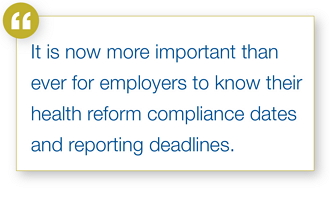Supreme Court upholds the Affordable Care Act's federal subsidies in recent King v. Burwell decision.
On June 27, the U.S. Supreme Court ruled
to uphold federal subsidies for approximately 6.4 million Americans who have
obtained health coverage through a federally-facilitated exchange. This ruling
sent a clear message to employers that the Patient
Protection and Affordable Care Act (PPACA) is here to stay. In a 6-3 vote, King V. Burwell is the second U.S.
Supreme Court ruling to uphold PPACA legislation since it was signed into law
in 2010.
 “Today’s ruling represents a call to
action for employers who have either ignored the law hoping it would go away,
or those that delayed signing contracts or postponed making benefit design changes,”
said Sibyl Bogardus, JD, Chief Compliance Officer, Western Region, HUB
International. “It is now more important than
ever for employers to know their health reform compliance dates and reporting
deadlines.”
“Today’s ruling represents a call to
action for employers who have either ignored the law hoping it would go away,
or those that delayed signing contracts or postponed making benefit design changes,”
said Sibyl Bogardus, JD, Chief Compliance Officer, Western Region, HUB
International. “It is now more important than
ever for employers to know their health reform compliance dates and reporting
deadlines.”
Although the King decision centered on subsidy payments, the ruling affirms many
of the PPACA regulations scheduled to take effect soon. The following are of
immediate concerns to all employers:
Reporting duties:
For employers with more than 50 workers, addressing PPACA IRS reporting
requirements looms as a critical immediate concern as failures could lead to
significant penalties.
Mandate on plan year anniversary: PPACA reform regulations allow employers to
begin mandate compliance on their plan anniversary date in 2015 (or 2016 for
middle sized employers), but unless key conditions are satisfied to start on
your plan anniversary date, the default date is January 1.
Employer Mandate: The Employer Mandate, in effect now for large
employers and coming soon to smaller groups, requires businesses to offer every
full-time employee and their dependents health care coverage, or face stiff
penalties. Furthermore, the Employer Mandate will identify organizations with
50 to 99 lives as “small businesses,” previously a distinction reserved for those
only with two to 49 lives. Premiums for small businesses of two to 99
lives will now be determined using standard "manual" rates
rather than taking into consideration their own industry code or claims
history. They will be mixed into a larger pool of companies with a variety of
demographics, leading to increased rates for many.
Cadillac
Tax:
Employers of all sizes will be subject to the PPACA’s Cadillac Tax, an excise
tax on “Cadillac” health care plans scheduled to take effect January 1, 2020. This
40% excise tax penalty on employers offering coverage that is too rich
(generally, plans with a value over $10,200 single and $27,500 for families)
will apply to every size business, even those under 50 lives, and could hit
small businesses sooner if their premium rates increase (as described above). Larger
employers -- and particularly those on the East coast where health care costs
are highest -- may already be hitting Cadillac Tax thresholds. Avoiding this
tax for as long as possible will be crucial. The government estimates 60%
of plans will pay the tax in the first year.
“Many employers were probably hoping on
some level that everything was going to go away – closing their eyes wishing
for some good outcome that would protect them from the looming change they’d
have to make down the road,” said Dennis Fiszer, Chief Compliance Officer, Eastern Region, HUB
International. “This ruling means employers won’t be shielded by the Supreme
Court. The status quo has been maintained and everything will proceed on
schedule.”
Plan
Ahead: Create a strategic employee benefits plan now
So many new requirements means employers
have to prepare today to be in compliance tomorrow. HUB suggests creating a
three-to-five year strategic employee benefits plan to rollout potential
benefits changes for all size employers including medical, voluntary, wellness
and more.
“Employers need to now ask themselves – ‘How
am I going to prepare my workforce for these changes?’ Communicating that an
organization may be required to reduce benefits will not be an easy message to
share,” said Bogardus. “A three to five year employee benefits plan allows an
employer to focus on where they’re going to land in 2018 and will help
optimally position them to help mitigate the possible pain down the road. Now
is the time to start preparing.”